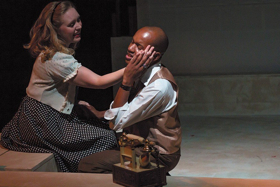Review: THE LIGHT IN THE PIAZZA at R-S Theatrics

Lonely woman finds true love in sunny, romantic, magical Italy! It's an all-too-familiar trope in films. It's happened to Kate (and Audrey) Hepburn, to Marisa Tomei, to Renée Zelwigger, to Miranda Richardson and others.
The Light in the Piazza is a 2003 musical based on a novella (1960) and a movie (1962); I was familiar with neither of these. I went to R-S Theatrics' production of the show and at first I thought it was going to be that same old tender but familiar story. We find ourselves in Florence somewhere in the '50's. Margaret Johnson and her daughter Clara are on vacation from their affluent life in Winston-Salem. They're doing something of a "Grand Tour". Clara meets and falls in love with a handsome young Fiorentino, and he with her. Mother disapproves.
But then we learn that there is some secret about Clara. She appears to be only a rather brattish and immature young woman. She's sweet, but given to temper tantrums when denied her way. We learn that there is a sad reason for her behavior: a head injury as a child left her mentally and emotionally impaired. Margaret, the mother, finds herself faced with a poignant moral dilemma. It's the sort of play that makes you talk about it for a long while afterward.
Should the damaged Clara be allowed to marry Fabrizio? That's the question that haunts Margaret--and it will haunt you too. Does he realize her limitations? Is it fair to him and his family? But can a mother deny a young woman the love of her life? Come and see. You decide.
Kay Love is always a fine performer, her voice lovely and true. Here she conveys an earnest mother's love and protectiveness. Macia Noorman captures the eagerness and innocence--and the fiery temper of Clara, and she can reach those high notes with startling power.
Fabrizio is played with wonderful charm and grace by Tiéler Cheatem. He has a beautiful pure voice, and his adoration of Clara is utterly convincing.
The Naccarellis, Fabrizio's family, are an adorable, complex incarnation of what it is to be Italian. Ken Coffel, as Papà, has that distinct, dignified carriage of the Italian pater familias--and such a great heart. Mamma is played quietly, but with wit and intelligence, by Jodi Stockton.
Fabrizio's brother and his wife, often embroiled in jealous hand-waving arguments, are played with great brio by Michael Lowe and Stephanie Merritt.
There are lovely unusual theatrical devices, the most significant of which is that several scenes among the Naccarellis are done in Italian. Supertitles are not used, nor are they at all needed. We see, we know exactly what is transpiring; titles would just be a distraction. What's more this profoundly Italian family seems to carry on their emotive conversations in opera. There are veritable arias, quartets, quintets flying around among them. It's all an Italian stereotype, of course, but it's a gloriously successful one. And it's not just a gimmick: it underscores the differences between the Italian family and the American one, and points up their difficulty in communication. Do the Naccarellis mistake Clara's idiosyncrasies for mere language problems that will disappear with fluency?
Once, late in the evening Signora Naccarelli steps out of the scene to address the audience. She really speaks no English, but nevertheless uses English to translate for us what is being said in Italian--it's just so important. This leads into a beautiful song about "Risk"; It is vital to be willing to take a risk-in love, and in life in general.
Another nice theatrical device appears when Margaret makes a trans-Atlantic call to her husband (strongly played by Robert Doyle). In this age before satellites there are slight delays before each hears what the other has spoken. It's a nice touch that emphasizes the difficulty that this troubled couple have in communicating.
There are brief dreamy sequences in which the lovely young Avery Smith appears as the childhood Clara; in one such memory there is a beautiful slow-motion reënactment of the tragic accident that left the child as she is.
Musically there is occasional use of vocalise--wordless singing. This is wonderfully effective in a rapturous lyrical duet between the young lovers. Later vocalise fills a most touching scene between Clara's mother and Fabrizio's father as they take a quiet walk to discuss the wisdom of allowing the wedding to go forward. Sometimes words are not the only (let alone the best) means of communication.
The orchestration is perfectly fitted to the emotional tone of the show: violin, cello, bass and harp. I love the fact that the singers used no microphones; there's no need at all for them in so small a venue. But even this small orchestra tended to dominate the singers. Please don't bring in microphones! Just urge the musicians, "Piano, piano!"
Director Christina Rios has given us a lovely, funny, thoughtful production. The Light in the Piazza continues through August 26 at the Marcelle in Grand Center.
Reader Reviews
Videos

